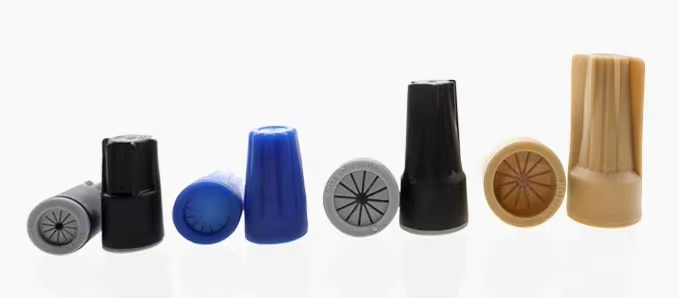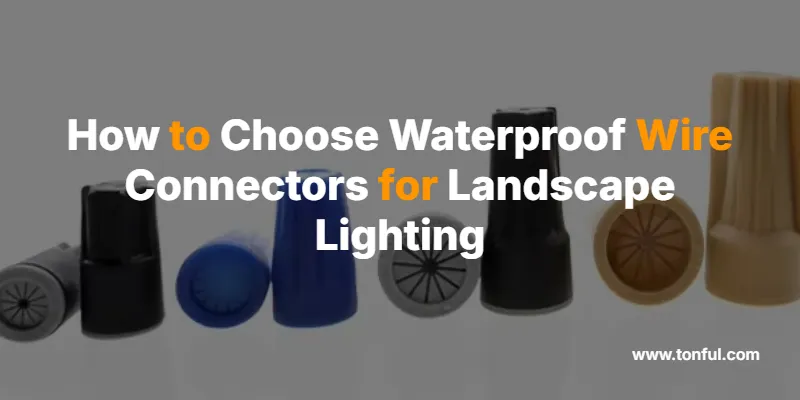Direct Answer: Choose waterproof wire connectors for landscape lighting based on your voltage requirements (12V vs 120V), wire gauge compatibility, IP rating (minimum IP65), and connection type needed. For most residential low-voltage systems, use silicone-filled direct burial connectors rated IP67 or higher with 12-14 AWG wire capacity.
The right waterproof wire connector prevents costly lighting failures, electrical hazards, and maintains your landscape lighting system’s performance for years. This comprehensive guide covers everything you need to make the correct choice for your specific installation requirements.
What Are Waterproof Wire Connectors for Landscape Lighting?

Waterproof wire connectors are specialized electrical components designed to join wires in outdoor lighting systems while preventing moisture infiltration. These connectors use gaskets, silicone gel, or heat-shrink materials to create watertight seals that protect electrical connections from rain, snow, irrigation water, and ground moisture.
Key Components:
- Housing material: Typically polycarbonate, nylon, or thermoplastic
- Sealing mechanism: Silicone gel, rubber gaskets, or heat-shrink tubing
- Contact points: Copper or brass terminals for reliable conductivity
- Strain relief: Built-in cable grips to prevent wire pull-out
Types of Waterproof Wire Connectors: Complete Comparison
| Connector Type | Best For | IP Rating | Voltage Capacity | Wire Gauge Range | Average Cost | Reusability |
|---|---|---|---|---|---|---|
| Silicone Gel-Filled | Direct burial, permanent connections | IP67-IP68 | 12V-120V | 12-18 AWG | $2-5 each | No |
| Heat Shrink with Adhesive | Above-ground splices | IP65-IP67 | 12V-600V | 10-22 AWG | $1-3 each | No |
| Threaded Compression | Junction boxes, frequent access | IP65-IP66 | 12V-240V | 12-16 AWG | $5-15 each | Yes |
| Twist-On Wire Nuts (Waterproof) | Quick connections, temporary use | IP54-IP65 | 12V-120V | 14-18 AWG | $0.50-2 each | Yes |
| Push-In Connectors | Fast installation, maintenance | IP54-IP67 | 12V-240V | 12-20 AWG | $3-8 each | Yes |
Silicone Gel-Filled Connectors
These premium connectors feature internal silicone gel that flows around wire connections, creating an impermeable seal. The gel self-heals minor punctures and accommodates thermal expansion.
Best Applications:
- Direct burial installations
- Wet location splices
- Long-term permanent connections
- Commercial landscape lighting
⚠️ Safety Note: Once sealed, these connectors cannot be reopened. Plan connections carefully before installation.
Heat Shrink Connectors with Adhesive
These connectors combine electrical insulation with waterproof sealing through heat-activated adhesive inner walls and outer shrink tubing.
Best Applications:
- Above-ground wire splices
- Fixture lead connections
- Repair of damaged cables
- Areas with temperature fluctuations
Expert Tip: Use a heat gun at 200-250°F for even shrinking. Overheating can damage the adhesive seal.
Threaded Compression Connectors
These mechanical connectors use threaded caps with rubber gaskets to compress around wire bundles, creating watertight seals while maintaining accessibility.
Best Applications:
- Junction box connections
- Maintenance-accessible locations
- Multi-wire splice points
- Professional installations requiring serviceability
Wire Gauge and Voltage Compatibility Guide
Low Voltage Systems (12V-24V)
| Wire Gauge | Maximum Distance | Recommended Connector Type | Typical Applications |
|---|---|---|---|
| 12 AWG | 250+ feet | Silicone gel-filled, compression | Main runs, high-wattage fixtures |
| 14 AWG | 150-200 feet | All connector types | Standard fixture connections |
| 16 AWG | 75-125 feet | Heat shrink, push-in | Short runs, accent lighting |
| 18 AWG | 50-75 feet | Wire nuts, push-in | Fixture leads, patch connections |
Line Voltage Systems (120V)
⚠️ Safety Warning: Line voltage installations require GFCI protection and compliance with NEC codes. Consider professional installation for safety and code compliance.
| Wire Gauge | Circuit Capacity | Required Protection | Connector Requirements |
|---|---|---|---|
| 12 AWG | 20 amp circuits | GFCI breaker/outlet | IP65+ rated, UL listed |
| 14 AWG | 15 amp circuits | GFCI breaker/outlet | IP65+ rated, UL listed |
IP Rating Requirements for Landscape Lighting
Understanding IP (Ingress Protection) ratings ensures you select connectors with appropriate water resistance for your installation environment.
IP Rating Breakdown
| IP Rating | Protection Level | Best Applications | Not Suitable For |
|---|---|---|---|
| IP54 | Limited dust, splashing water | Covered areas, temporary connections | Direct burial, irrigation zones |
| IP65 | Complete dust seal, water jets | Above-ground permanent installations | Submersion, direct burial |
| IP67 | Complete dust seal, immersion to 1 meter | Direct burial, wet locations | Long-term submersion |
| IP68 | Complete dust seal, continuous submersion | Underwater applications, extreme conditions | General landscape use (overkill) |
Professional Recommendation: Use minimum IP65 for all landscape lighting connections, IP67 for direct burial applications.
Installation Methods and Best Practices
Direct Burial Installation Steps
- Excavate to proper depth (6-18 inches depending on local codes)
- Strip wire insulation to manufacturer specifications (typically ½ inch)
- Insert wires into connector ensuring full contact with terminals
- Seal according to type:
- Gel-filled: Push wires fully into gel chamber
- Heat shrink: Apply heat evenly from center outward
- Compression: Tighten to specified torque (typically 15-20 in-lbs)
- Wrap with electrical tape for additional protection
- Backfill carefully avoiding sharp objects near connections
Above-Ground Installation Requirements
- Mount in junction boxes rated for wet locations
- Provide drip loops to direct water away from connections
- Use strain relief to prevent wire pull-out
- Allow for thermal expansion in connector placement
Expert Tip: Apply dielectric grease to threaded connections to prevent corrosion and ease future removal.
Common Problems and Troubleshooting
Connection Failures
Symptoms: Flickering lights, complete circuit failure, blown fuses
Causes: Moisture infiltration, loose connections, incompatible wire gauges
Solutions:
- Verify IP rating matches environment
- Check wire gauge compatibility
- Ensure proper installation techniques
Corrosion Issues
Symptoms: Green/white buildup on connections, high resistance
Causes: Dissimilar metals, inadequate sealing, poor drainage
Solutions:
- Use connectors with same metal types (copper-to-copper)
- Apply dielectric grease
- Improve site drainage
Thermal Expansion Problems
Symptoms: Loose connections in winter, tight connections in summer
Causes: Temperature cycling, inadequate strain relief
Solutions:
- Use flexible connector designs
- Install during moderate temperatures
- Provide adequate cable slack
Safety and Code Compliance
National Electrical Code (NEC) Requirements
Low Voltage Systems (Class 2):
- Use Class 2 rated wire and connectors
- Maximum 30V, 100VA power supply
- No conduit required for direct burial cable
Line Voltage Systems:
- GFCI protection required for all outdoor circuits
- Use THWN-2 rated wire in wet locations
- Follow local burial depth requirements (typically 18-24 inches)
⚠️ Safety Warning: Always turn off power at the breaker before making electrical connections. Use a non-contact voltage tester to verify circuits are de-energized.
Local Code Considerations
- Building permits may be required for line voltage installations
- Inspection requirements vary by jurisdiction
- Burial depth regulations differ by location and voltage
- GFCI protection standards have specific requirements
Professional Recommendation: Consult local electrical codes and consider professional installation for line voltage systems to ensure safety and compliance.
Selection Criteria: How to Choose the Right Connector
Step 1: Determine Your System Requirements
Voltage Classification:
- Low voltage (12V-24V): More flexibility in connector choice
- Line voltage (120V): Stricter safety and code requirements
Environmental Conditions:
- Direct burial: Requires IP67+ rating
- Above ground: IP65 minimum acceptable
- Submersion areas: IP67-IP68 required
Step 2: Calculate Wire Gauge Needs
Distance Considerations:
- Measure total wire run length
- Account for voltage drop (3% maximum recommended)
- Size wire gauge accordingly
Load Requirements:
- Calculate total wattage of connected fixtures
- Add 20% safety margin for future expansion
- Verify connector current rating exceeds calculated load
Step 3: Evaluate Installation Environment
Soil Conditions:
- Clay/wet soils: Higher IP rating required
- Sandy/well-drained soils: Standard IP65 acceptable
- Areas with irrigation: Consider drainage patterns
Temperature Range:
- Check connector operating temperature range
- Account for seasonal temperature swings
- Consider thermal expansion effects
Step 4: Factor in Maintenance Access
Permanent Installations:
- Gel-filled connectors for highest reliability
- Document connection locations for future reference
Serviceable Connections:
- Compression or threaded connectors
- Install in accessible junction boxes
- Provide clear labeling system
Expert Buying Guide and Recommendations
Premium Connectors (Professional Grade)
Best Overall: King Innovation WeatherProof Wire Connectors
- Features: Silicone gel-filled, IP68 rated, wide temperature range
- Applications: Premium residential and commercial installations
- Price Range: $3-6 per connector
- Wire Capacity: 12-18 AWG, up to 6 wires
Best Value: 3M Scotchlok DBR/Y Series
- Features: Heat shrink with adhesive, reliable seal, economical
- Applications: Standard residential landscape lighting
- Price Range: $1-3 per connector
- Wire Capacity: 14-18 AWG, 2-3 wires
Budget-Friendly Options
Good Performance: Ideal In-Sure Push-In Connectors
- Features: Reusable, tool-free installation, decent water resistance
- Applications: Above-ground connections, temporary installations
- Price Range: $0.75-2 per connector
- Wire Capacity: 12-20 AWG, lever-operated
Specialty Applications
Marine Grade: Ancor Heat Shrink Butt Connectors
- Features: Tinned copper, adhesive-lined, extreme corrosion resistance
- Applications: Coastal installations, high-salt environments
- Price Range: $2-5 per connector
High Temperature: Raychem XAGA Heat Shrink Splices
- Features: Operating range -55°F to +275°F, flame retardant
- Applications: Desert climates, industrial installations
- Price Range: $4-8 per connector
Quick Reference Connector Selection Chart
| Installation Type | Recommended Connector | IP Rating | Estimated Cost | Installation Difficulty |
|---|---|---|---|---|
| Direct Burial, Permanent | Silicone gel-filled | IP67-IP68 | $3-6 each | Easy |
| Above Ground, Accessible | Threaded compression | IP65-IP66 | $5-15 each | Moderate |
| Quick Repairs | Heat shrink with adhesive | IP65-IP67 | $1-3 each | Easy |
| Temporary Connections | Waterproof wire nuts | IP54-IP65 | $0.50-2 each | Very Easy |
| High-Traffic Areas | Push-in with enclosure | IP65+ | $5-10 each | Moderate |
Frequently Asked Questions
What’s the difference between IP65 and IP67 rated connectors?
IP65 connectors protect against water jets from any direction but are not rated for immersion. IP67 connectors can withstand temporary immersion up to 1 meter depth for 30 minutes. For direct burial landscape lighting, IP67 provides better long-term protection against groundwater infiltration.
Can I reuse silicone gel-filled connectors?
No, silicone gel-filled connectors are designed for permanent installation. Once the gel sets around the wires, the connection cannot be safely reopened without destroying the seal. Use threaded compression connectors if you need reusable connections.
How deep should I bury landscape lighting wire connections?
For low voltage systems, bury connections 6-12 inches deep, following local codes. Line voltage connections typically require 18-24 inches depth. Always verify local burial requirements, as they vary by jurisdiction and voltage level.
What wire gauge should I use for a 150-foot lighting run?
For 150-foot runs with standard landscape lighting, use 12 AWG wire to minimize voltage drop. Calculate total fixture wattage and use voltage drop calculators to verify appropriate wire sizing. Undersized wire leads to dim lighting and connector overheating.
Are twist-on wire nuts suitable for outdoor landscape lighting?
Only use wire nuts specifically rated for wet locations with appropriate IP ratings. Standard indoor wire nuts will fail quickly outdoors. Even waterproof wire nuts are better suited for above-ground, accessible connections rather than direct burial applications.
How often should I inspect landscape lighting connections?
Inspect accessible connections annually, checking for corrosion, loose connections, and seal integrity. Direct burial connections sealed with quality connectors typically don’t require regular inspection but should be checked if lighting performance changes.
Can I connect different wire gauges with the same connector?
Most quality connectors accommodate a range of wire gauges, but verify compatibility before installation. Mixing significantly different gauges (like 12 AWG to 18 AWG) may not provide reliable connections. Use step-down connectors designed for gauge transitions when necessary.
What tools do I need for connector installation?
Basic installations require wire strippers, heat gun (for heat shrink types), and electrical tape. Professional installations may need torque wrenches for compression connectors, multimeters for testing, and trenching tools for burial work.
Professional Installation Recommendations
When to Call a Professional:
- Line voltage (120V) system installations
- Complex multi-zone lighting systems
- Installations requiring permits or inspections
- Troubleshooting persistent connection problems
- Integration with home automation systems
DIY-Friendly Projects:
- Low voltage system connections
- Single fixture additions
- Connector replacements on existing systems
- Above-ground splice repairs
⚠️ Final Safety Reminder: Always follow local electrical codes and manufacturer instructions. When in doubt about electrical safety or code requirements, consult a licensed electrician. Proper connector selection and installation ensures safe, reliable landscape lighting for years to come.
Expert Takeaway: Choose waterproof connectors based on your specific voltage requirements, environmental conditions, and maintenance needs. Invest in quality IP67-rated connectors for direct burial applications, and always prioritize safety compliance over cost savings. Proper connector selection prevents costly failures and ensures long-term lighting system reliability.

